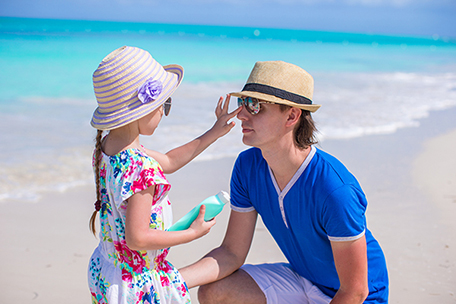Sun Exposure

When you are outdoors, you may be exposed to the sun’s harmful ultraviolet (UV) rays. When your UV exposure is prolonged, you are at risk for both short-term issues, like sunburns, and long-term issues such as, sun damage, premature aging, and skin cancer.
You may be at a higher risk for UV exposure depending on your activities and where you are traveling. Learn how to protect yourself from the sun during travel below.
Protect Yourself from the Sun
You are at the highest risk for UV exposure when you are traveling near the equator, during summer months, at high elevations, or between 10 am to 4 pm. You can also be exposed to UV rays on cloudy days and during the winter. UV rays reflect on the snow, sand, and water. Protect yourself from the sun during any outdoor activities.
Use Sunscreen
Sunscreen protects you from sun exposure by reflecting or absorbing UV rays. Here are some tips on how to apply and select sunscreen:
- Use sun protection factor (SPF) 15 or higher.
- Ensure your sunscreen “blocks UVA and UVB” or has “broad spectrum” on the label.
- Apply sunscreen to create a thick layer on the skin at least 20 minutes before you are put in the sun.
- Apply sunscreen to all exposed skin, including ears, scalp, lips, neck, tops of feet, and backs of hands.
- Reapply at least every 2 hours.
- Reapply each time you get out of water or sweat heavily.
- If you are also using insect repellent, apply sunscreen first and insect repellent second. Follow product label instructions to determine how often you need to reapply insect repellent and sunscreen.
- Throw away containers of sunscreens after 1–2 years.
Wear Protective Clothing
- Wear clothing to cover as much skin as possible.
- Wear a hat with a wide brim to shade the face, head, ears, and neck.
- Wear sunglasses that block both UVA and UVB rays.

Take Additional Steps
- Stay in the shade, especially during midday hours (10 am to 4 pm).
- Drink plenty of non-alcoholic fluids.
- Avoid indoor tanning facilities. Getting a “base tan” before your vacation damages your skin and does not protect you from sun exposure on your trip.
How to Treat a Sunburn
- Take aspirin, acetaminophen, or ibuprofen to relieve pain, headache, and fever.
- Drink plenty of water.
- Soothe burns with cool baths or by gently applying cool, wet cloths.
- Use a topical moisturizing cream or aloe to provide additional relief.
- Do not go back into the sun until the burn has healed.
- If your skin blisters, lightly bandage or cover the area with gauze to prevent infection. Do not break blisters as that would slow healing and increase your risk of infection. Apply antiseptic ointment if blisters break.
Seek medical attention if you have a severe sunburn, especially if it covers more than 15% of your body, are dehydrated, have a high fever, or are in extreme pain that lasts more than 48 hours.
More Information
- CDC Yellow Book: Sun Exposure
- Travel to Hot Climates
- Sun Exposure in CDC’s National Institute for Occupational Safety and Health